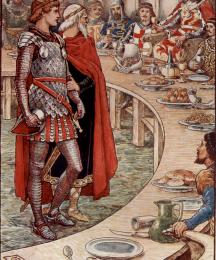
Wace first introduces the notion of the Round Table in his Roman de Brut. Wace writes that King Arthur had it made so that all of the noble barons whom he attracted to his court would be equally placed and served and none could boast that he had a higher position at the table than the others. Layamon expands on this notion, describing a riot at which many nobles vie for place and precedence at Arthur’s table. A skilled craftsman then offers to make Arthur a table that will seat more than sixteen hundred and at which high and low will be on an equal footing because the table is round. It is also constructed in such a way that it can be transported when Arthur travels. Béroul’s Tristran suggests that the Round Table revolves like the earth.
According to the prose rendition of Robert de Boron’s Merlin and the thirteenth-century Vulgate Cycle, Uther Pendragon, instructed by Merlin, established the Round Table to symbolize the table of the Last Supper and the Grail Table established by Joseph of Arimathea at the command of the Holy Spirit. Uther gives the Round Table to Guinevere’s father Leodegan, who in turn gives it to Arthur when he weds Guinevere. John Hardyng’s Chronicle also claims that the Round Table is made in commemoration of the Grail Table. In the Vulgate Queste del Saint Graal, the Round Table is said to represent the world, a significance supported by the fact that knights come to it from all the countries where chivalry exists. Malory says similarly that Merlin made the table round to signify the roundness of the world.
Der Stricker suggests in his Daniel...
Read More
According to the prose rendition of Robert de Boron’s Merlin and the thirteenth-century Vulgate Cycle, Uther Pendragon, instructed by Merlin, established the Round Table to symbolize the table of the Last Supper and the Grail Table established by Joseph of Arimathea at the command of the Holy Spirit. Uther gives the Round Table to Guinevere’s father Leodegan, who in turn gives it to Arthur when he weds Guinevere. John Hardyng’s Chronicle also claims that the Round Table is made in commemoration of the Grail Table. In the Vulgate Queste del Saint Graal, the Round Table is said to represent the world, a significance supported by the fact that knights come to it from all the countries where chivalry exists. Malory says similarly that Merlin made the table round to signify the roundness of the world.
Der Stricker suggests in his Daniel...
Read More
Collins, W. Lucas (1815 - 1887)
Hawker, Robert Stephen (c. 1803 - 1875)
Rhys, Ernest (1859 - 1946)
Warton, Thomas (1728 - 1790)











